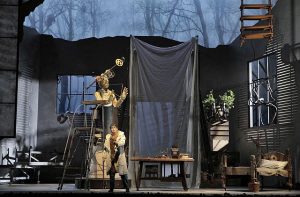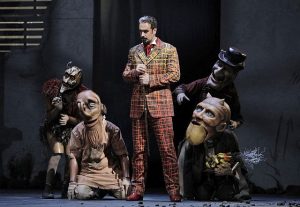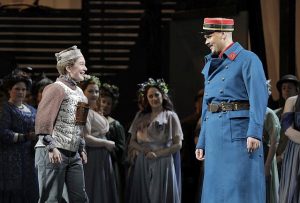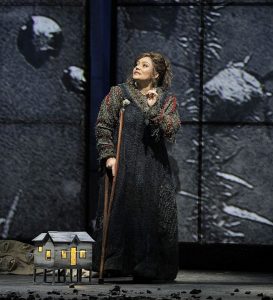HIGHLY RECOMMENDED
The first clue that the Lyric’s 2018 production of Charles Gounod’s ‘Faust’ will have an unusual rendering comes immediately in the opening scene during the opera’s lyrical introductory music.
While Faust, portrayed as an aged artist and sculptor, is lying on a bed in his studio, a video, possibly of his anxious dreams about the world outside, is projected on a large drape at the other side of the room.
He wakes and while singing of his frustration of a loveless life (Rien! En vain j’interroge ) climbs his scaffolding to a surreal, sculptured figure holding a scientific styled telescopic instrument.
When his attempts to drink a poison there are interrupted by a choir he descends to a table with wood blocks and calls for help from the devil.

It is Faust’s own carving of the devil’s agent, Méphistophélès, shown as a projection on a drape near him, that is another important clue to this production’s tone.
It presents the possibility that Méphistophélès and the demons that will be surrounding him during the opera are the creation of Faust’s own tormented self. The demons definitely look like carved figures.
Faust’s carving of Méphistophélès comes to life behind the drape near him and they sing the fine duet (Me voici). After tempting Faust with a projection of the beautiful, young Marguerite, the suicidal artist is willing to sell his soul to the devil to become young and experience love.
And so, Act I sets the atmosphere created by the opera’s production designer, California sculptor /film maker John Frame, set and costume designer Vita Tzykun, video designer David Adam Moore and lighting designer Duane Schuler.

Under the superb direction of Kevin Newbury, the production team’s magic and the remarkable voices and fine acting of the entire cast all come together for a magnificent “Faust.”
Making his American debut, French tenor Benjamin Bernheim brings wonderfully rich nuances to the arias of Faust, including a beautiful rendition of (Salut, demeure chaste et pure) in Act III.
Ryan Opera Center alumnus Christian Van Horn’s fine bass-baritone is perfect for Méphistophélès. He has the flashy, jazzy demeanor of a ringmaster conducting the action.
It was evident by enthusiastic applause for Bernheim and Van Horn at the end of the first act, that audiences knew they were in for an operatic treat.

A highlight of Act II is baritone Edward Parks singing (O sainte médaille … Avant de quitter ces lieux) as Valentin, Marguarite’s brother. He tells the young boy, Siébel who adores Marguarite, to watch over her. There were more than a few “bravos”for Parks.
Although there seemed to be no worthy reason to make the character of Marguerite handicapped and give her a crutch, soprano Ailyn Pérez impressively takes hold of the role of a young, guileless, religious girl who is seduced, becomes pregnant and then abandoned.
She moves from sparkling in the famed Jewel Song (Ah! je ris de me voir si belle en ce miroir) to sadness in the aria (Il ne revient pas) after abandoned by Faust and then to emotional strength in the love duet she sings with him (Oui, c’est toi que j’aime) when she is in prison.

The excellent cast also includes two mezzo sopranos, Jill Grove as Marguerite’s nosy neighbor Marthe and Annie Rose as Siébel.
As always, the Lyric’s chorus and orchestra sound grand but kudos must also go to Conductor Emmanuel Villaume who beautifully interprets Gounod’s music. Villaume is often called upon to conduct French operas.
Sung in French with English subtitles (often called projected translations), the libretto is by Jules Barbier and Michel Carré. It is based on “Faust et Marguerite” by Carré that was somewhat based on Johann Wolfgang von Goethe’s “Faust, Part One.”
The character of Faust has become so popular that similar to Scrooge as a name for someone who is a miser, Faustian has been coined to mean a bargain with the devil or a greedy or promoting action made without thought or care about the consequences.
The Lyric production takes advantage of current technology to project death symbols, the devilishly persuasive magic of a Méphistophélès type of person and the yearnings of someone who knowingly opts for the Faustian path. It does overuse skeletons by having them move too much instead of occasionally shadowing the action.
However, Lyric’s 2018 “Faust” amazingly couples surrealistic art with the story’s surreal aspects while it keeps its centuries-old German flavor. Of course, outstanding voices and Gounod’s lyrical music truly put this production on the must-see list.
DETAILS: ‘Faust’ is at the Lyric Opera House, 20 N. Wacker Drive, Chicago, now through March 21, 2018 (Ana María Martínez assumes the role of Marguarite on Mar. 21). For tickets and other information visit Lyric Opera/Faust.
Jodie Jacobs
For more shows, visit TheatreInChicago.
